► Taycan takes on rivals
► Petrol, PHEV and Tesla
► Which one comes out on top?
Supercar speed, usability and clean power; the Porsche Taycan and Tesla Model S promise it all. Which is best? And might a V8 BMW M5 or hybrid Polestar 1 be a better bet?
Pre-flight briefing: Porsche Taycan
Why is it here?
Because it’s a Porsche, an EV, and Porsche’s first (modern) EV. But where exactly does it fit in? Is the Taycan good for an electric car, or good full stop? Are we simply relieved that Porsche hasn’t embarrassed itself? Does the Taycan offer much beyond the EV double-act of ridiculous acceleration and silent running? And would you take one over our reigning super-saloon king, the BMW M5?
Best electric cars
Any clever stuff?
Nothing but clever stuff. There’s a two-speed rear gearbox where most EVs keep their ratios fixed, for efficient high-speed running and a bludgeoning launch. The engineering in the motors makes them expensive but power-dense. The brakes offer way more feel than we’ve come to expect from EV regen systems. But perhaps the Taycan’s most significant innovation is that it’s designed for tomorrow’s chargers as well as today’s. The Taycan has an 800-volt electrical system, rather than the more usual 400 volts. That makes for slimmer, lighter cabling and the potential for ultra rapid charging. Although there are currently very few 800-volt, 270kW charging stations, if you find one you should be able to get a 60-mile top-up in five and a half minutes, or go from five per cent full to 80 per cent in 23 minutes. But the Taycan’s also ready to use basic 11kW AC chargers, and everything in between those extremes.
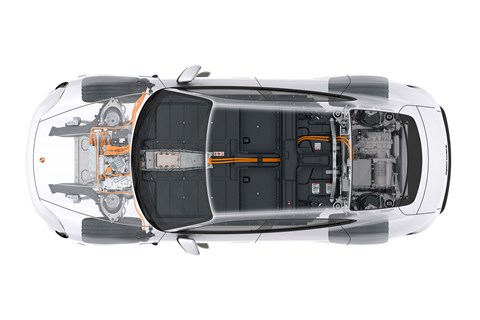
Which version is this?
The range-topping Turbo S, which has active rear steer, carbon-ceramic brakes and an over-boost function. The mid-rank Turbo has the same battery but reduced performance. The 4S, the current entry-level Taycan, is priced from just over £83k – the same money as a 911 Carrera…
Read our Porsche Taycan review
Pre-flight briefing: BMW M5 Competition
Why is it here?
Because the M5 remains the benchmark for performance saloons, and a recent Giant Test winner against the equally rapid, all-wheel-drive and not cheap AMG GT Four Door and Audi RS6. The F90-generation M5 is a couple of years old now but that doesn’t stop it being a fabulous car. Yes, it’s mostly about driving hard, but the BMW is a genuine five-seater with a decent boot that makes long journeys realistic for passengers as well as the driver. Top-drawer infotainment and that badge only add to the desirability of the best car BMW currently makes.
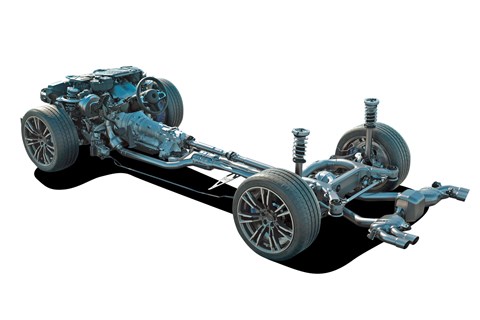
Any clever stuff?
The configurable xDrive system is genius, blending the real-world benefits of rear-wheel drive with a full-time rear bias and the option to cut power to the front axle altogether. Dial in your preferences and you can head straight to your favourite settings using the M1 and M2 steering-wheel buttons. Other tweakable parameters include steering weight, damping and shift brutality.
Which version is this?
The M5 Competition, which is now the only M5 offered in the UK. Compared to the regular M5 it has a sportier exhaust, another 25bhp and, when you fork out for the optional Driver’s Pack, a higher top speed, the restricter now cutting in at 190mph rather than 155. The ride height is lowered, the dampers recalibrated, the springs stiffened and steering geometry tweaked.
Read our BMW M5 Competition review
Pre-flight briefing: Tesla Model S Performance
Why is it here?
Because it’s the battery-electric benchmark against which the Taycan must be judged. The Model S showed that an all-electric car from a cocky start-up could be fast, sophisticated and good to drive. The Model S blends a huge battery with front and rear e-motors, all-wheel drive, adaptive air suspension, big boots and a clean, modern interior – a game-changing combination.
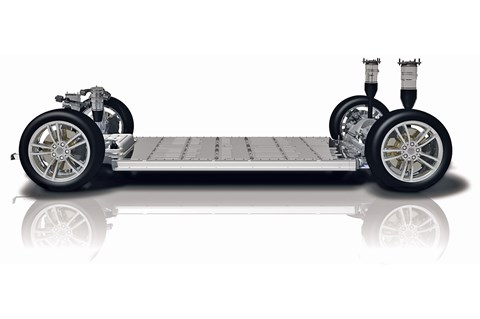
Any clever stuff?
Our test car doesn’t have the latest software update, released in late April, which allows the battery to run hotter and therefore facilitate repeated hard acceleration runs in Ludicrous mode without power fade – a Model S issue highlighted in this test. The update also includes the Cheetah Stance setting for Launch Control starts, whereby the front air suspension squats down, the rear stays high and the damping is adjusted for optimum traction. Tesla claims a standing quarter-mile time of 10.4sec – the same as Lamborghini’s Aventador SV.
Which version is this?
Tesla endlessly fiddles with its line-up, sometimes beaming over-the-air software updates to owners unannounced, sometimes changing model names. This is the Performance version (previously P100D) of the Model S, as distinct from the Long Range version. It benefits from spring 2019’s hardware upgrades, known as Raven, which included fitting a new adaptive suspension system, installing more comfortable seats and providing a longer range between charges. This was done not by changing the batteries but by replacing the front electric motor with the more efficient motor previously found in the rear of the smaller, more affordable and newer Model 3.
Read our Tesla Model S review
Pre-flight briefing: Polestar 1
Why is it here?
Because the Polestar 1 is a boldly different performance-orientated plug-in hybrid, whereas so many PHEVs are just about on-paper economy. The 1 makes a big statement about how high the new brand – spun off from Volvo, and under the same Geely ownership – is aiming. Style-focused early adopters are clearly in Polestar’s sights, but so are drivers who want some of the startling acceleration made possible by the torque characteristics of electric motors.
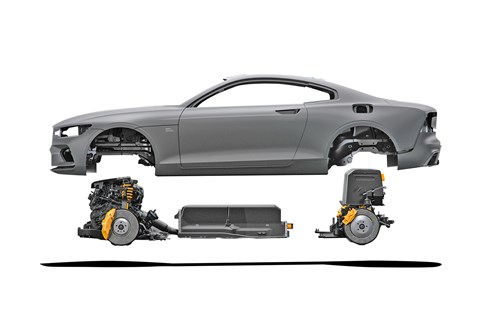
Any clever stuff?
The way the petrol engine up front (a turbocharged and supercharged 2.0-litre four derived from the Volvo XC90’s, boosted by an integrated starter-generator) interacts with the two electric motors at the back is highly unusual, but makes sense and works well. The planetary gear sandwiched between the electric drive units distributes the grunt between the rear wheels. Rather than leading lives of their own, the front and rear drive modules are synchronised for optimum traction and entertaining handling by integrated torque vectoring. But perhaps equally significant is that this is the group’s first experience of crash testing carbonfibre. Polestar’s studied the way in which carbon dissipates energy by cracking and shattering, rather than deforming like steel – expect the learnings to spread far and wide through Geely.
Which version is this?
There’s just the one version of the Polestar 1, with metallic paint the only option. Makes sense, given that it’s a limited edition of at most 1500 cars, all of them left-hand drive.
Read our Polestar 1 review
The introduction
We’re unleashing the Taycan on a stretch of lightly trafficked and unrestricted autobahn – a sure-fire formula for a broad smile accompanied by a big, fat inner conflict. While the devil inside begs you to succumb to the electric Porsche’s dynamic persuasions, the voice of reason urges you to back off. Because even at a relatively modest 125mph, the distance-to-empty display is in freefall. In the new automotive world order, if you want the pleasures of rapid progress you must also come to terms with range anxiety and charge anxiety – the fear of running out, and the fear of a long wait to recharge.
Or do you? Is it too soon to consider electrification an essential part of the mix? The BMW M5 represents the best of the old school. It (arguably irrelevantly) has a higher top speed than the Taycan, and a superior range. Driven like you’d drive a petrol-fed turbo, Porsche’s EV runs out of juice after about 130 miles. In the hands of an equally ambitious driver, the BMW will do nearly double that distance. (CAR’s German sister title Auto Zeitung measured energy consumption across a range of driving conditions to calculate ranges of 370 miles for the M5 Comp, 259 for the Model S Performance and 198 for the Taycan Turbo S.) Bunkering 60-plus litres of Shell’s finest is a five-minute routine, not a thumb-twiddling 20 minutes (the best you can hope for from the Porche’s many charging options).
Perhaps the best answer for 2020 is a plug-in hybrid. The most advanced option at the performance saloon end of the market is the limited-edition Polestar 1, which has an electric-only range of a currently unrivalled 77 miles, but also a giddy price: £139,000. The plan is to build 500 a year, and 1500 in total. The 1 combines a highly tuned 2.0-litre four-cylinder petrol engine from parent company Volvo with an electrified rear axle. Together, the two power sources generate supercar power. That’s the good news. The bad news is that the thing’s environmental credentials are less than water-tight.
And then there’s the Tesla Model S – an answer that’s been staring us in the face for eight years now. The inoffensive design has barely changed since June 2012 but the technology within has, the Model S evolving in leaps and bounds to make the competition look lame time and again.
On the road
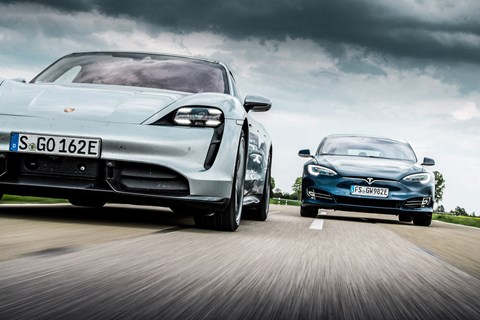
This fully loaded 751bhp Taycan Turbo S comes with a sticker price of £160,000. That number is hard to swallow, especially when compared to a 571bhp Taycan 4S for £88k. Our Raven edition Model S, rated at 785bhp, would swipe £103k off your bank account. If acceleration in a straight line is what matters most, the Tesla is the bang-per-buck winner. If driving pleasure is the decider, though, the key question is how much of Porsche’s trademark dynamic excellence has made it into the Taycan Turbo S. If exclusivity is the number one priority, the hand-built 602bhp Polestar looks hard to beat. And if your conscience is untroubled by concerns over fossil fuels, the 616bhp M5 – £98k in base trim – will be top of your list.
In convoy, flying along empty rural roads made emptier still by the news story of the year/decade/century, our convoy is as unlikely as it is impressive. Where we must slow before accelerating again, for tight corners and junctions, the two pure EVs are deeply impressive, their acceleration shocking. With Launch Control engaged, the Porsche will use its overboost capability to storm from 0-62mph in 2.8sec. But the ⊲ Tesla, at least on its first run, can shave two-tenths off the Taycan’s time. But in a way that’s just odd when you grew up with combustion-engined cars, repeatability isn’t always a given in a fast EV. The Taycan can stay on the bright side of 3.0sec 0-62mph for up to 10 consecutive attempts; the Model S simply can’t manage that. The Tesla’s Ludicrous mode is worth its weight in PR gold, but after repeated acceleration runs that gold turns out to be less than solid. Keep pushing it and it can overheat, and even go into limp-home mode. (A recent software update addresses this issue.)
The BMW may look – and sound – old-fashioned in this company, but it’s a very highly evolved old-fashioned car. On one straight stretch, the Tesla and Taycan off ahead fighting for EV supremacy, I couldn’t care less that the BMW takes a full 3.3sec to go 0-62mph. As it fires down the road its musical V8 pulls your brain down into a great big vat of happy. Your eardrums and adrenal glands are just as well catered for. The Polestar? Caught between stools, it is neither EV fast (0-62mph takes 4.2sec) nor melodious like the M5.
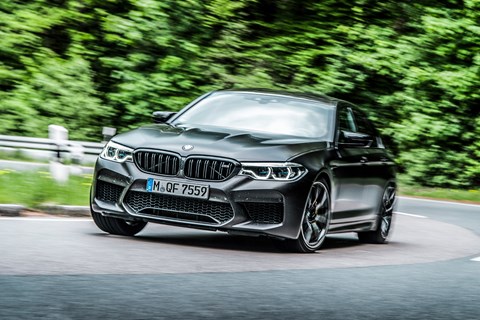
Already ahead from a standing start, the EVs blow the hybrid and V8 M5 into the weeds on rolling acceleration. With the Tesla in Ludicrous mode and the Porsche in Sport Plus, they’re both quicker than the BMW between 30 and 60mph and 50 and 75mph. The Polestar struggles to keep up, as does reality at times – overtaking in the Tesla and Porsche is an experience bordering on the surreal. You may well have spent decades learning to juggle momentum, timing and gear selection to reduce the amount of time spent on the wrong side of the road, but in these EVs you don’t need any it – just pull out and put your foot down.
While the Polestar’s figures aren’t as extraordinary as the Tesla or Taycan’s, the 1 would be considered very rapid in any other company. Driving all four wheels without a mechanical link between the axles, the Polestar’s hybrid powertrain deserves a gold medal for torque management. Ample power and irresistible twist are generated by three different sources: the 304bhp combustion engine, a 70bhp starter generator and two 114bhp e-motors. The deployable aggregate is 602bhp and 738lb ft. Thanks to the 34kWh battery – potent by PHEV standards – the coupe ⊲ can, in Pure mode, cover almost as many zero-emission miles as a Smart EQ. The fast-acting bespoke Öhlins dampers can be adjusted in five steps via the drive mode selector or, by spanner, in 22 stages from cotton wool to unyielding, circuit-ready concrete. The vast 21-inch tyres (275/30, 295/30) grip like a hungry dog’s jaws.
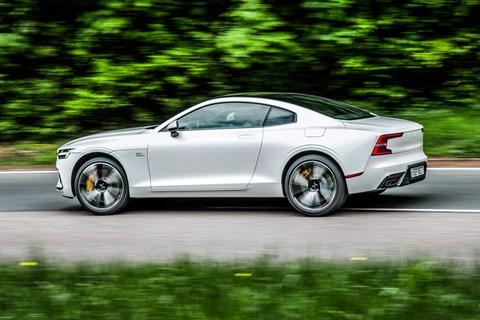
On the move the 1 is a magician of flow, masterfully orchestrating near-noiseless, electric-only rear-drive power and the additional effort of the front (engine-driven) wheels. The car’s ECU juggles the two with foresight and astounding smoothness. Drawbacks? The four-cylinder engine sounds gruff when pushed (as it does in the Volvo XC90), tramlining can be an issue (to be expected on wheels and tyres like a concept car’s), and the automatic gearbox dices progress into eight very perceivable chunks. Merits? The steering is well connected yet not easily perturbed by the engine’s 310lb ft tugging on its arms. And ample grip and strong traction don’t get in the way of playfulness – the handling is involving and failsafe, offering everything from elegant skating to feinted sliding.
As with any plug-in hybrid, so much of the value of the Polestar depends on when, where and how you use it. It can get you through otherwise off-limits zero-emission zones, but it can also mean you’re carrying around a lot of weight and bulk. The 1 is a car that demands you get involved, on every level. Behind the wheel, in your dedication to charging it, in tuning its talented chassis to suit your style – with the Polestar you get out what you put in.
The same is also true of the M5, but for dynamic tactility the BMW eclipses even the very cool, idiosyncratic Swede. It takes over where your nervous system ends and by doing so puts the road in the palms of your hands, connects body and car like a soft-shell magnet. Despite countless microchips the BMW feels analogue in the way it moves, sounds and works with you. The 4.4-litre engine, xDrive and the M Sport differential distribute the M5’s considerable muscle mass with a rare instinct for balance and proportion.
The optional (£7495) carbon-ceramic rotors have a reassuring grip on the car’s substantial weight and momentum, but they could respond a little more promptly, act more progressively and be less heavy on the leg muscles. The variable-rate, variable-effort steering is a meaty and precise if somewhat synthetic control, while the chassis covers the full repertoire from grand cruiser to drift-meister. The M5 rides surprisingly well on some surfaces but as the road deteriorates, so too does the compliance in the Competition’s suspension – even the Tesla feels more supple, while the Taycan offers a broader spread of compression and rebound. The Polestar 1 is borderline firm but never unduly rough. But the M5 scoops a bunch of crucial bonus points at the limit of adhesion, where an on-demand set of different attitudes and a greater degree of involvement make the four-door saloon a more exciting drive overall.
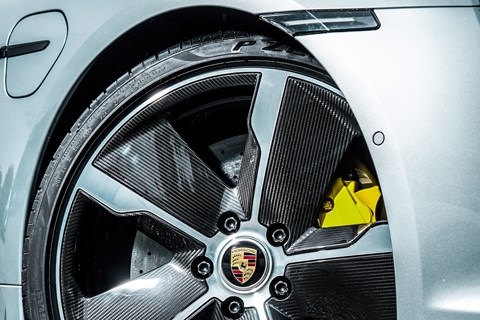
The car from California was sensationally good for a first effort from a newcomer but it’s getting long in the tooth. The presentation isn’t special enough, and the Tesla lacks both the novelty value of the Porsche and the Polestar’s sense of the occasion. To qualify as a hardcore high-roller for g-force explorers, the Model S needs more focused steering, stronger brakes and a more ambitious chassis. Directionally stable, devoid of prima donna-ish airs and graces, it is virtually immune to provocation. Push it beyond its limits for bags of terminal understeer.
Which is where the Porsche has the advantage. It was developed in a world in which Tesla had already shown what was possible. But Porsche hasn’t copied every aspect of the Model S. Contrary to the Tesla, which first introduced the one-pedal feel, the Turbo S prioritises coasting over regeneration. This makes a huge difference on B-roads, where the Porsche shines as an effortless glider capable of devouring tarmac at a dizzying rate. The transition from electric to hydraulic deceleration is all but imperceptible at any speed, and at any pedal pressure. Indeed the Taycan’s stopping distances eclipse even the 911 GT2 RS, which takes some beating. It’s this awesome and almost surreal fast-forward, fast-rewind cycle that lingers in the memory well into the night. Last time this happened, it was after a day spent in the Ferrari 488 Pista.
The Taycan has an uncommonly low, sports car-like driving position, a totally connected feel to the steering, exceptional roadholding and the ability to carry apparently impossible cornering speeds. Assisted by the subtle but effective rear-wheel steering, the torque-vectoring effect of the all-wheel drive automatically reins in your recklessness, although stick it in Sport Plus with ESP Off and you can enjoy power oversteer, M5-style, but without the billowing tyre smoke.
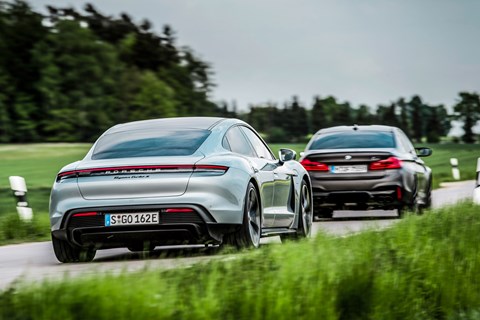
The Taycan resembles a five-door 911 and is an accordingly tight fit. For this kind of money you’d expect classier surface materials, more supple leather and better ergonomics, rather than that low-mounted black touchscreen which smears up in no time. The three main dials can be configured via the controls on the steering-wheel, the direction of travel is selected by a toggle switch next to the main monitor, the ignition key replaced by an on/off button. The prettiest detail is the curved, boomerang-shaped centre binnacle which harks back to the very first 911.
Unlike the Model 3, the Model S still has two displays, a smaller one in front of the driver, and an upright XXL tablet which occupies most of the centre console. There are no knobs or switches bar a couple of thumbwheels on the helm. Initially irritatingly large, the format of the main visual and haptic interface grows on you with use, and the sat-nav is much more detailed and precise than any of the competition. In addition, the Tesla is roomier than its rivals, the huge boots swallow far more luggage, and the Autopilot feature can be an asset as long as you understand its shortcomings. But the heavily coated leather seats don’t look or feel remotely bovine in origin, the random panel gaps would have Ferdinand Piëch spinning in his grave, and the fit and finish varies from atrocious (door seals) to well below par (low-rent carpet, scratch-prone surfaces), and the whole presentation is soulless and lacklustre.
The M5’s interior is BMW at its best; top-notch quality, great seats, fingerprint-free iDrive and all the assistance systems you could want – and then some. The Polestar suffers for its eye-catching looks. It sits on a modified version of Volvo’s SPA architecture, shortened by 320mm. The contraction improves the proportions but destroys the packaging, hence the token rear seats and tiny cargo area (just 126 litres when fitted with the charge cable storage bag). Unlike the equally fetching all-electric Polestar 2, the marque’s first offering borrows almost the entire cockpit assembly with the Volvo S90/V90. Visibility is good, and the bespoke seats really comfortable, but the main eye-catcher is the well designed composite body, which saves 240kg over a hull made of steel.
A winner, you say? This won’t be easy, but if splitting cars as simultaneously similar and disparate was easy we’d all be doing it, right?
Final reckoning
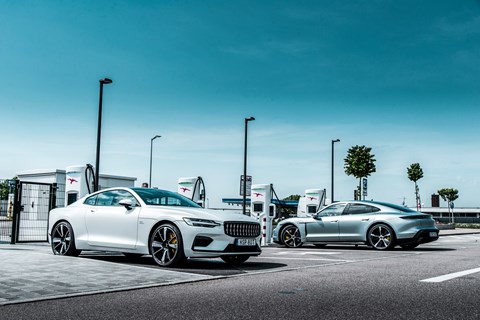
The big loser of this match is the referee. If the M5 wins, the arbiter can only be a backward-looking, narrow-minded petrolhead. Put the Taycan first instead and be perceived as a tech junkie who turns a blind eye to the minimum range requirements of a daily driver.
Putting infrastructure to one side is a big call but one we surely make. After all, who would wade into the world of £150k EVs without first having checked they have an appropriate usage scenario and off-street charging capability?
If you do, it’s easy to be swept up in the brilliance of the Taycan Turbo S. Less practical and more expensive than the Tesla, and with less range and fewer charging options (truly Musk’s Supercharger network was a stroke of genius…), the Porsche fights back to eclipse the Model S with its mighty dynamic talents. If your lifestyle renders the challenge of charging on the fly redundant, dare to try the Porsche – but bear in mind that the Taycan 4S is a much better deal than the Turbo S.
If you must go on relying on liquid energy from a pump, the M5 more than makes the grade – and promises to do so for years to come. For me, the BMW gets the vote on merit, and not simply by virtue of being easy to fuel. The next M5 will almost certainly be electrified. Until then this V8 epitomises the art of classical performance automotive engineering. Ultimately slower and noisier than the Taycan, it wins nonetheless thanks to the intimacy of the relationship it nurtures between car and driver. The BMW is a machine able to communicate with man, wordlessly, in real time, and with a nuance of language that beggars belief. The Taycan is agile, involving and alert for a battery-electric car, but that caveat is key – the M5 is more affecting; reaches deeper into your heart and your soul.
The Polestar is a dark horse which, with its knockout looks and brilliant chassis, threatens to snare your heart as effortlessly as the BMW. But ultimately the package is too expensive, too flawed and, unless fully charged, isn’t in the same performance ballpark as the rest of the group, either. It’s a compromise, but not a compelling enough one to let you off the hook. No, you must choose: are you ready for electric? Porsche is ready if you are; BMW if you’re not.
Taycan vs M5 vs Model S vs Polestar 1: verdict
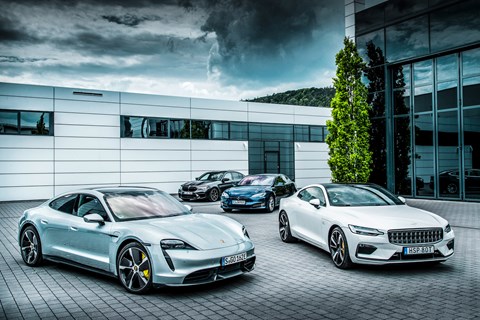
First place: BMW M5 Competition
Forget infrastructure and CO2 – this is simply the most enjoyable and rewarding car here to drive.
★★★★★
Second place: Porsche Taycan Turbo S
Astonishingly effective; thrillingly quick and composed; hugely desirable; very expensive.
★★★★★
Third place: Tesla Model S Performance
The Tesla’s excellent fundamentals have been impressively upgraded yet again, but S feeling its age now.
★★★★
Fourth place: Polestar 1
Stretches the plug-in hybrid envelope in a new direction, but flawed and expensive.
★★★★
Further electric car reading
The best electric cars on sale today
How much does it cost to charge an electric car?
The fastest electric cars
Your guide to electric car batteries
Longest-range EVs